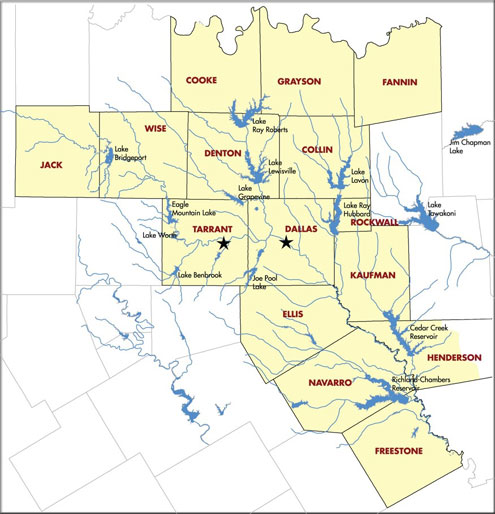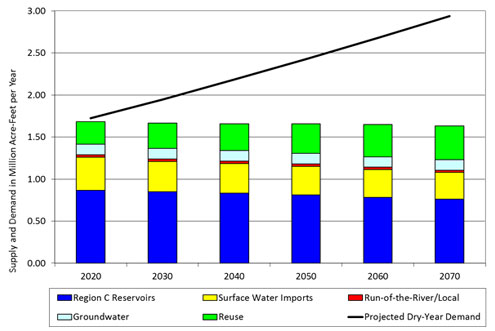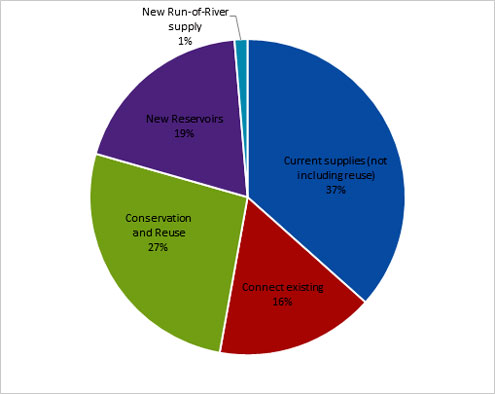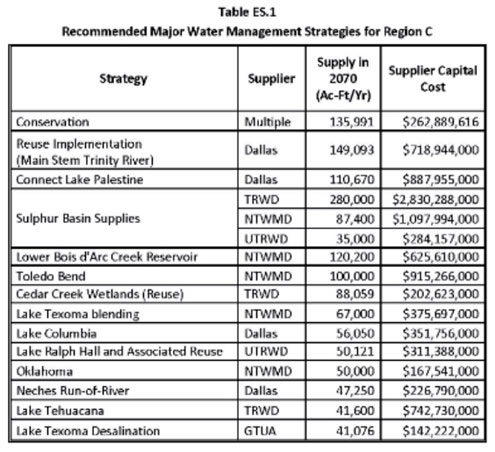After extensive research and evaluation of potential water management strategies over the past few years, the Region C Water Planning Group (RCWPG) recently approved a draft version of its 2016 Region C Water Plan – known formally as the Initially Prepared Plan (IPP). The draft plan provides for water management strategies to address the needs of North Central Texas’ growing population, which is expected to more than double by 2070.
The draft plan now goes through a review by the public and various state agencies, before adoption as a final Regional Water Plan later this year. The IPP is available for public review on the Region C website, www.regioncwater.org, and it is also available in each county clerk’s office and at least one public library in each of Region C’s 16 counties (see website for a complete list).
On the evening of Wednesday, June 24, 2015, the RCWPG will host a public hearing at the Bob Duncan Center in Arlington, where public comments on the draft plan will be accepted. For more information about this hearing and how to submit comments, see the next story in this e-newsletter.
The following article provides an overview of the IPP, to assist the public with navigating its contents prior to the public hearing and the end of the public comment period.
The first section of the IPP is an Executive Summary, which provides a concise overview of the 11 chapters in the draft plan. For many readers, this summary – at fewer than 30 pages – will be a good way to see the big picture of the overall plan.
Chapter One of the IPP provides a description of Region C, covering topics such as the region’s economic activity, physical features, water suppliers, current water uses and demand centers, and various other water-related issues. It is worth noting that the region covers all or part of 16 counties in North Central Texas, with most of Region C in the upper portion of the Trinity River Basin, although there are smaller parts in the Red, Brazos, Sulphur and Sabine River Basins.

Most of North Central Texas’ water supply comes from 34 major reservoirs in the region, as well as some other reservoirs outside of Region C. About 90 percent of the water demand in Region C is met by surface water (reservoirs), but groundwater can be an important source of supply, too, especially in rural areas. Aquifers in the region include the Trinity, Woodbine, Carrizo-Wilcox, Nacatoch and Queen City. Reclamation of wastewater for water reuse purposes is rapidly increasing in Region C, and water reuse is planned to be a significant source of future water supplies for the region.
Total regional water use in the year 2011 was just over 1.5 million acre-feet. It is interesting to note that Region C, with over 25 percent of Texas’ population, had only 8.3 percent of the state’s water use in 2011. About 90 percent of current water use in Region C is for municipal supply – meaning residential, non-industrial commercial/retail and institutional water uses.
Chapter Two includes population and demand projections for the region through 2070. The population of Region C is projected to grow from nearly 6.5 million in the year 2010 to just over 9.9 million in 2040 and over 14.3 million by 2070. Dry-year water demands in Region C are expected to reach 2.2 million acre-feet per year by 2040, and 2.9 million acre-feet per year by 2070, largely due to population growth.
One of the biggest changes in this IPP, compared to the previous plan, is in the calculation of long-term water demands. In the 2011 Region C Water Plan, projected water demands averaged about 200 gallons per capita daily (gpcd). For the 2016 plan, Region C is now using noticeably lower per capita demands: averaging 165 gpcd before conservation and reuse strategies have been implemented. This change is attributable to several factors, including: significant progress in water conservation region-wide; use of a different base year for calculations of projected demands (the gpcd figure is now derived from year 2011 data, which wasn’t as dry a year as the previous base year); and the expectation that Region C entities with lower gpcd figures will grow faster than some entities with higher gpcd figures.
Employing this newer figure reduces the overall projected regional water demand by 590,000 acre-feet annually in 2060, compared to the projections in the 2011 plan (note that a side-by-side comparison for year 2070 projected demands isn’t possible, as the 2011 Region C Water Plan only covered up to the year 2060).
Chapter Three gives an overall summary of the water supplies currently available to Region C. Without new water sources, currently available supplies will remain almost constant over time at 1.7 million acre-feet per year, as sedimentation in reservoirs is offset by increases in reuse supplies due to increased return flows.
Chapter Four identifies water needs in Region C, based on the comparison of currently available water supplies and projected demands over time. With the projected 2070 demand of 2.9 million acre-feet per year, the region projects a shortage of 1.2 million acre-feet per year by 2070 – which is why planning and development of new water management strategies is so critical.
Chapter Five deals with the identification, evaluation and selection of water management strategies. This section is perhaps most of interest to the public, as it outlines what Region C specifically plans to do, in terms of new water strategies, in order to meet future demands.

The Region C Water Planning Group identified and evaluated a wide variety of potentially feasible water management strategies in developing its plan. It then evaluated the water management strategies based on a number of factors:
- Quantity, reliability and cost of water delivered and treated
- Environmental factors
- Impacts on other water resources and on threats to agricultural and natural resources
- Other factors deemed relevant by the planning group (including consistency with the plans of other water providers in the region)
- Consideration of interbasin transfer requirements and third-party impacts of voluntary water redistributions
The major recommended water management strategies for Region C are listed below in Table ES.1. Major strategies are those supplying over 60,000 acre-feet per year or involving the construction of a reservoir.
In total, the draft 2016 plan calls for water management strategies that would create 1.68 million acre-feet per year of additional water supplies, creating a total available supply of 3.31 million acre-feet per year in 2070. This supply is about 13 percent greater than the projected demand, leaving a reasonable reserve to provide for: difficulties in developing strategies in a timely manner, droughts worse than the drought of record, greater than expected growth, and supply for needs beyond this planning horizon.

It is worth noting that, of the supply available to the region in 2070, about 37 percent is already available from surface water and groundwater. About 27 percent of the 2070 supply would be developed from water conservation and reuse strategies, which is notable and represents perhaps the most ambitious conservation and reuse effort in the entire state.
By 2070, 16 percent of the available water supply would be created from connections to existing supply sources, and the remaining 20 percent would be from the development of new supplies, including reservoirs and run-of-river projects. The draft plan includes only five major new reservoirs, compared to more than 25 developed to supply water to Region C over the last 60 years.
The total projected cost of implementing the water management strategies in the draft plan is $21.7 billion.

Chapter Six describes the impact of the Regional Water Plan and consistency with long-term protection of water, agricultural and natural resources, including its impact on water quality, the impacts of moving water from rural and agricultural areas and impacts to third parties.
Chapter Seven details the regional drought response strategy. It includes information concerning historical droughts in the region, current drought preparations and responses, and recommendations for future, region-specific drought responses and contingency plans.
Chapter Eight provides updates related to unique stream segments, reservoir sites and legislative recommendations, which will facilitate the orderly development, management and conservation of water resources. The draft 2016 plan adds Lakes Columbia and George Parkhouse North to the list of recommended unique sites for future reservoir construction, and calls for several other legislative recommendations, including expanded eligibility for SWIFT funding.
Chapter Nine summarizes infrastructure funding recommendations. This section will be completed for the final 2016 Region C Water Plan, based on a survey to be performed by the Texas Water Development Board.
Chapter Ten describes the plan approval process and options that have been provided, or will be provided, in order to inform the public and encourage them to participate in the planning process.
Chapter Eleven is one of the new requirements for the 2016 Regional Water Plans. This chapter details the implementation of the 2011 plan and provides a comparison between that plan and the new, draft 2016 plan.
Since the development of the last (2011) Region C Water Plan, changes that have occurred include:
- Implementation of 29 water management strategies called for in the earlier plan
- 252 water management strategies in the previous plan are no longer being considered by regional WWPs or WUGS (many of which pertain to supplemental wells)
- Overall projected water demands have decreased (as detailed above)
- Total available supplies have decreased
- Overall projected water needs have decreased (as detailed above)
- The total cost for implementation of the recommended strategies is similar
The Region C Water Planning Group appreciates the public’s attention to the draft plan, and looks forward to receiving and considering comments, whether provided at the June 24 public hearing or through mailed/e-mailed submissions.